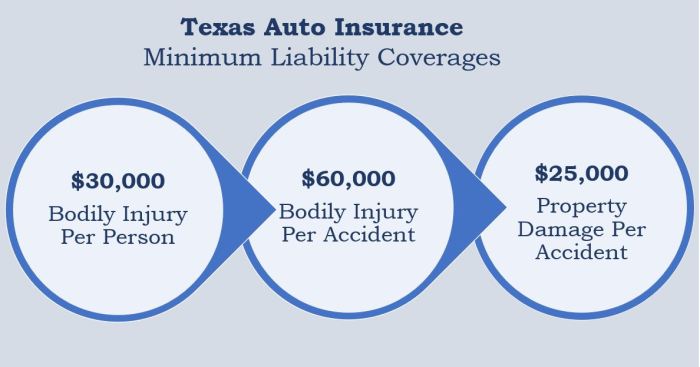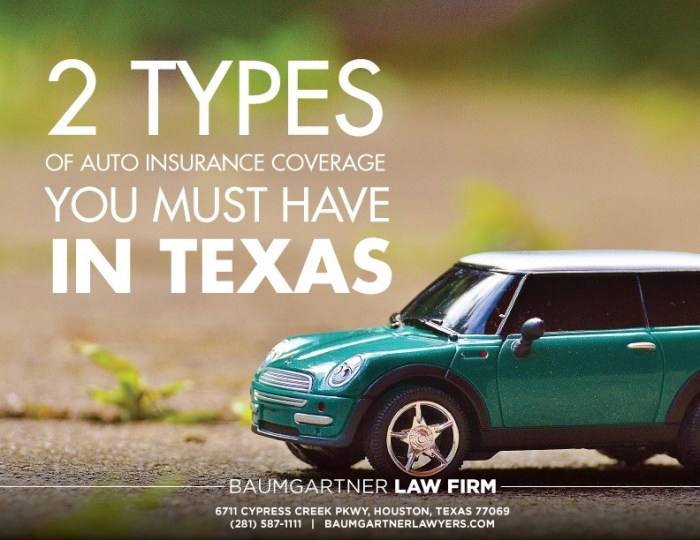
Securing the right auto insurance in Texas can feel overwhelming, given the diverse coverage options and state-specific regulations. This guide aims to demystify the process, providing clear explanations of Texas’s auto insurance requirements, factors influencing premiums, and strategies for finding the best coverage at a competitive price. We’ll explore everything from understanding liability coverage to navigating the claims process, empowering you to make informed decisions about your auto insurance needs.
Understanding Texas auto insurance isn’t just about meeting legal requirements; it’s about protecting your financial well-being and ensuring peace of mind on the road. This guide will equip you with the knowledge to compare policies, understand your rights, and effectively manage potential risks. From choosing the right coverage to handling claims, we’ll provide the tools you need to confidently navigate the Texas auto insurance landscape.
Texas Auto Insurance Requirements

Driving in Texas requires adhering to specific auto insurance regulations to ensure financial protection in case of accidents. Understanding these requirements is crucial for all Texas drivers to avoid legal repercussions and financial burdens. This section details the minimum coverage mandates, penalties for non-compliance, and a breakdown of common insurance coverage types.
Minimum Liability Coverage in Texas
Texas law mandates minimum liability coverage for all drivers. This means you must carry a minimum amount of insurance to cover damages you cause to others in an accident. The minimum requirement is 30/60/25. This translates to $30,000 in bodily injury liability coverage per person injured, $60,000 in total bodily injury liability coverage per accident, and $25,000 in property damage liability coverage. Failure to meet this minimum can result in significant penalties.
Penalties for Driving Without Insurance in Texas
Driving without the state-mandated minimum auto insurance in Texas is illegal. Penalties are severe and can include hefty fines, license suspension, and even vehicle impoundment. The specific penalties can vary depending on the circumstances and the number of offenses. Repeat offenders face increasingly stringent consequences. It’s important to remember that even a short period of driving uninsured can lead to significant financial and legal repercussions.
Common Auto Insurance Coverage Types in Texas
Several types of auto insurance coverage are available in Texas, each offering different levels of protection. Understanding these options is essential for choosing a policy that meets your individual needs and budget.
| Coverage Type | Description | Typical Cost Factors | Benefits |
|---|---|---|---|
| Liability | Covers bodily injury and property damage you cause to others in an accident. | Driving record, age, location, vehicle type. | Protects you from financial ruin if you cause an accident resulting in injuries or property damage to others. |
| Collision | Covers damage to your vehicle resulting from a collision, regardless of fault. | Vehicle’s make, model, year, and value; deductible amount. | Pays for repairs or replacement of your vehicle after an accident, even if you are at fault. |
| Comprehensive | Covers damage to your vehicle from non-collision events such as theft, vandalism, fire, or hail. | Vehicle’s make, model, year, and value; location; deductible amount. | Protects your vehicle from damage caused by events outside of collisions. |
| Uninsured/Underinsured Motorist | Covers your injuries and vehicle damage if you are involved in an accident with an uninsured or underinsured driver. | Driving record, age, location. | Provides crucial protection in cases where the at-fault driver lacks sufficient insurance. |
| Medical Payments | Covers medical expenses for you and your passengers, regardless of fault. | Driving record, age, location. | Helps pay for medical bills after an accident, regardless of who is at fault. |
Factors Affecting Auto Insurance Premiums in Texas

Several key factors influence the cost of auto insurance premiums in Texas. Understanding these factors can help you make informed decisions and potentially save money on your insurance. This section will explore the primary elements that insurance companies consider when determining your premium.
Driving History
Your driving record significantly impacts your insurance rates. A clean driving history, free of accidents and traffic violations, will generally result in lower premiums. Conversely, accidents, speeding tickets, DUIs, and other moving violations can lead to substantially higher premiums. Insurance companies view these incidents as indicators of higher risk, justifying increased costs to compensate for the potential for future claims. The severity of the violation also plays a role; a major accident will have a more significant impact than a minor fender bender. For example, a driver with multiple speeding tickets within a short period might see their premiums increase by 20-40% or more, compared to a driver with a clean record.
Age and Gender
Age and gender are statistical factors used in insurance rate calculations. Younger drivers, particularly those under 25, typically pay higher premiums due to their statistically higher accident rates. As drivers gain experience and age, their premiums generally decrease. Gender can also influence rates, although this is becoming less prevalent due to legal challenges and changing risk assessments. Historically, young male drivers have been statistically associated with higher accident rates than young female drivers. However, it’s important to remember that these are statistical averages; individual driving habits are the most crucial determinant of risk.
Credit Score
In Texas, credit-based insurance scores are often used to determine insurance premiums. A good credit score can lead to lower premiums, while a poor credit score can result in higher premiums. The reasoning behind this is that individuals with good credit are statistically more likely to be responsible and less likely to file fraudulent claims. This correlation is not universally accepted, but it remains a significant factor in many Texas insurance companies’ rating systems. The impact of credit score varies by insurer, but a difference of several hundred dollars per year is not uncommon between drivers with excellent and poor credit.
Vehicle Type, Location, and Driving Habits
Several other factors contribute to auto insurance costs. The type of vehicle you drive influences premiums; sports cars and luxury vehicles often command higher premiums than more economical models due to higher repair costs and increased risk of theft. Your location also matters; areas with higher crime rates or more frequent accidents typically have higher insurance premiums. Finally, your driving habits, while not always directly measurable, are considered. Factors like mileage driven annually and the purpose of your driving (commute vs. recreational) can impact your rates. For instance, someone who commutes long distances daily might pay more than someone who primarily drives for short errands.
Flowchart Illustrating Auto Insurance Premium Calculation
A simplified flowchart illustrating the process could be as follows:
Start –> Gather Driver Information (Age, Gender, Address, Driving History, Credit Score) –> Assess Risk Based on Information –> Determine Base Premium –> Apply Discounts/Surcharges (e.g., Safe Driver, Good Student, Multi-Car) –> Calculate Final Premium –> Issue Policy.
Texas-Specific Auto Insurance Laws and Regulations
Navigating the intricacies of Texas auto insurance law is crucial for all drivers. Understanding the specific regulations ensures compliance and protects your rights in the event of an accident or claim. This section details key aspects of Texas’s auto insurance laws, focusing on uninsured/underinsured motorist coverage, the appeals process for claim denials, the legal ramifications of driving with a suspended license, and the responsibilities of drivers involved in accidents.
Uninsured/Underinsured Motorist Coverage in Texas
Texas law requires drivers to carry a minimum amount of liability insurance, but not all drivers comply. Uninsured/underinsured motorist (UM/UIM) coverage protects you if you’re injured by an uninsured or underinsured driver. This coverage can pay for your medical bills, lost wages, and pain and suffering. While not mandatory, purchasing UM/UIM coverage is highly recommended, as it significantly reduces your financial risk in the event of an accident with an at-fault driver lacking sufficient insurance. The amount of UM/UIM coverage you choose is a personal decision, but it should be carefully considered in light of your potential exposure. Choosing a policy with UM/UIM coverage equal to or greater than your liability coverage is often advisable.
Appealing an Insurance Claim Denial in Texas
If your insurance claim is denied, you have the right to appeal the decision. The process typically involves submitting a detailed letter outlining your reasons for disagreement, along with supporting documentation such as medical records, police reports, and witness statements. The insurance company is required to review your appeal and provide a written response within a reasonable timeframe. If the appeal is unsuccessful, you may need to consult with an attorney to explore further legal options, such as filing a lawsuit against the insurance company. Texas law provides specific guidelines regarding the handling of insurance claims and appeals, and these should be carefully reviewed.
Legal Implications of Driving with a Suspended License in Texas
Driving with a suspended license in Texas carries serious consequences. It’s a criminal offense that can result in fines, jail time, and further suspension of your driving privileges. The penalties can increase with each subsequent offense. Furthermore, driving with a suspended license can impact your ability to obtain insurance in the future, and it may complicate matters if you’re involved in an accident. A suspended license indicates a disregard for traffic laws, and this could lead to more significant penalties if you’re involved in a crash.
Responsibilities of Drivers Involved in Accidents in Texas
Following an accident in Texas, drivers have several legal responsibilities. These include stopping at the scene, providing identification and insurance information to other involved parties, and contacting the police to file a report. Failing to fulfill these responsibilities can lead to legal repercussions. Additionally, drivers are obligated to cooperate fully with law enforcement during the investigation and to truthfully report the circumstances of the accident. Drivers should also take steps to document the accident, such as taking photographs and obtaining contact information from witnesses. Accurate documentation can be crucial in resolving insurance claims and any potential legal disputes.
End of Discussion

Successfully navigating the world of Texas auto insurance requires understanding your legal obligations, evaluating your risk profile, and actively comparing available options. By carefully considering the factors Artikeld in this guide – from minimum liability coverage to the influence of your driving history and credit score – you can secure a policy that provides adequate protection without unnecessary expense. Remember to review your policy regularly and don’t hesitate to seek clarification from your insurer when needed. Driving safely and responsibly is the best way to minimize risks and maintain affordable premiums.
Clarifying Questions
What happens if I get into an accident and I’m not at fault?
Even if you’re not at fault, your collision coverage will typically cover repairs to your vehicle. Your liability coverage will cover the other party’s damages and injuries.
Can I choose my own repair shop after an accident?
Generally, yes, but your insurer might have preferred providers. Check your policy for details.
How often can I expect my auto insurance rates to change?
Rates can change annually, or even more frequently, depending on your insurer and changes in your risk profile (driving record, location, etc.).
What is uninsured/underinsured motorist (UM/UIM) coverage and why is it important in Texas?
UM/UIM protects you if you’re involved in an accident with an uninsured or underinsured driver. It’s crucial because many drivers in Texas lack sufficient coverage.
What is the grace period for paying my auto insurance premium?
Grace periods vary by insurer. Check your policy documents or contact your insurer directly.